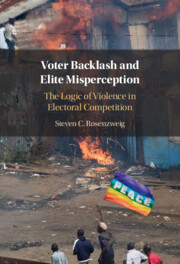Book contents
- Frontmatter
- Dedication
- Contents
- Figures
- Tables
- Preface
- Acknowledgements
- 1 Introduction
- 2 Election-Related Violence in Kenya and around the World
- 3 Theorizing Election-Related Violence: Toward a Theory of Elite Misperception
- 4 Violence and Election Outcomes
- 5 How Violence Affects Voting: Coercion, Persuasion, and Backlash
- 6 Elite Misperception and Election-Related Violence
- 7 Voter Backlash, Elite Misperception, and Violence beyond Kenya
- 8 Conclusion
- Appendix A Sampling Strategy for the Survey in Nakuru, Kisumu, and Narok
- Appendix B Supplementary Analyses
- Appendix C Candidate Vignettes and Outcome Questions
- Appendix D Politician Information Experiment Memo and Contact Scripts
- References
- Index
5 - How Violence Affects Voting: Coercion, Persuasion, and Backlash
Published online by Cambridge University Press: 18 May 2023
- Frontmatter
- Dedication
- Contents
- Figures
- Tables
- Preface
- Acknowledgements
- 1 Introduction
- 2 Election-Related Violence in Kenya and around the World
- 3 Theorizing Election-Related Violence: Toward a Theory of Elite Misperception
- 4 Violence and Election Outcomes
- 5 How Violence Affects Voting: Coercion, Persuasion, and Backlash
- 6 Elite Misperception and Election-Related Violence
- 7 Voter Backlash, Elite Misperception, and Violence beyond Kenya
- 8 Conclusion
- Appendix A Sampling Strategy for the Survey in Nakuru, Kisumu, and Narok
- Appendix B Supplementary Analyses
- Appendix C Candidate Vignettes and Outcome Questions
- Appendix D Politician Information Experiment Memo and Contact Scripts
- References
- Index
Summary
This chapter analyzes the effects of violence – via coercion and persuasion – on voting. Existing research provides some evidence that violence can be used to prevent voters from turning out to vote. However, an analysis of the relationship between violence and turnout in Kenyan elections in the 1990s finds no relationship between violence on the one hand, and the aggregate level of voter registration or turnout on the other, suggesting that the relationship between violence, turn-out and electoral geography may be less straightforward than previously thought. On persuasion, the analysis finds consistent evidence of a large and broad-based voter backlash against violence, including among the coethnic voters that politicians rely on to win elections. Furthermore, while antagonistic ethnic rhetoric does appear to increase the likelihood of violence breaking out, it is not a useful strategy for mobilizing coethnic support. These results suggest that voter backlash against violence and violent rhetoric may undermine the efficacy of violence as an electoral tactic, and they help explain why violence is not associated with better outcomes for candidates in real elections.
Keywords
- Type
- Chapter
- Information
- Voter Backlash and Elite MisperceptionThe Logic of Violence in Electoral Competition, pp. 86 - 114Publisher: Cambridge University PressPrint publication year: 2023



